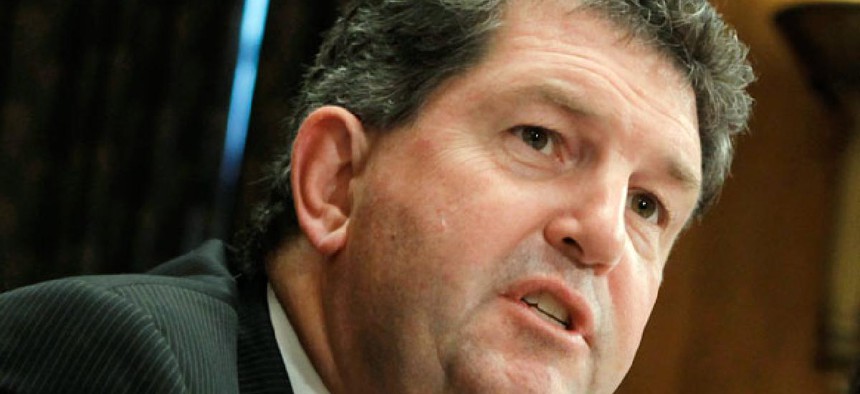
Postmaster General Patrick Donahoe J. Scott Applewhite/AP
Postal Service plan to drop federal health program faces murky future
Claims of $7 billion in annual savings generate some skepticism among House lawmakers.
The U.S. Postal Service’s proposal to withdraw from the Federal Employees Health Benefits Program is likely to be included in legislation due for debate on Capitol Hill next month, but lawmakers on both sides of the political spectrum remain skeptical that it would solve the cash-strapped agency’s fiscal woes.
USPS claims that leaving FEHBP and providing its own employee and retiree health benefit plan would save $7 billion annually and eliminate the need for further scheduled prefunding of retiree health benefits. Under the proposal -- part of a five-year business plan unveiled in February -- active employees initially would be covered under a simplified plan similar to FEHBP. The Postal Service would establish a separate program for new hires following private sector best practices, including incentives for Medicare-eligible beneficiaries to enroll in Medicare and wellness programs.
Debate on the Senate’s bipartisan postal reform bill originally slated for this week is unlikely to occur until mid-April, according to The Federal Times. That bill includes a measure that would require USPS to negotiate with its unions to develop a health care plan. The legislation also would restructure its prefunded retirement health benefit requirement.
About $21 billion of $25 billion total in Postal Service losses over the past five fiscal years stemmed from a provision in a 2006 law requiring the agency to prefund its retiree health benefits, according to USPS Postmaster General Patrick Donahoe.
“We have insufficient revenue to cover our costs and are rapidly approaching our statutory debt limit of $15 billion,” Donahoe said in testimony before the House Oversight and Government Reform Subcommittee on the Federal Workforce, U.S. Postal Service and Labor Policy on Tuesday.
Even if lawmakers adopt the Senate’s proposal and eliminate USPS’ prefunding requirement entirely, the Postal Service still would want to withdraw from FEHBP, Donahoe told reporters.
“We never can stop trying to be as efficient as possible and that means looking at health care and continuing to manage a network even after the 2016 time frame,” he said.
Rep. Darrell Issa, R-Calif., chairman of the full committee, said he would “probably support” the Postal Service’s health plan proposal but had reservations. He said the agency’s contention that it could generate $60 billion in revenue in 2015 with all the reforms in its five year business plan was a “rosy” scenario.
“Let’s have no illusions, you’re just cost shifting,” Issa told Donahoe. “There’s no cost savings to the American people. The money will be paid out of one hand in order to save it in another hand.”
According to Walton Francis, an economist and independent analyst who also testified at Tuesday’s hearing, health care premiums for other General Schedule and nonpostal workers would decrease if Postal Service employees left FEHBP since USPS’ workforce skews older than that of other agencies.
Despite that possibility, the National Association of Retired and Federal Employees still opposes the proposal, said Julie Tagen, NARFE’s legislative director.
“Nothing [Donahoe] says allays the fears of retirees, workers or taxpayers,” Tagen told Government Executive. They would be better off if USPS focused solely on eliminating its prefunding requirement payments first, she said.
Francis said the Postal Service’s health care expenses would rise by about 10 percent if it left the governmentwide program and no longer benefited from the larger and younger on average insurance pool.
Nonetheless, the agency could save nearly $500 million annually under its own program, simply by contributing less to premium costs, he said.
“It is more than passingly ironic that a USPS system facing ever more devastating competition, including parcel carriers and the Internet, fails to understand that competition among competing health plans drives down costs while improving service,” he said.
Francis recommended that postal employees be encouraged to switch from one of the highest cost plans offered through FEHBP to one of the 12 lowest cost plans offered. He estimates that could generate roughly $2,000 per employee in savings. USPS could offer $200 per year to employees who agree to switch to the lower cost plan, he suggested.
CORRECTION: The original version of this story misstated the political affiliation of Rep. Darrell Issa. He is a Republican.






